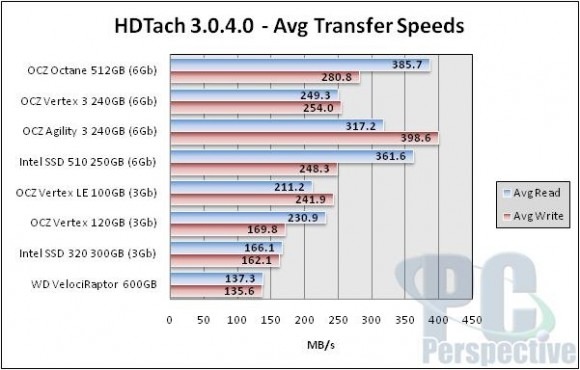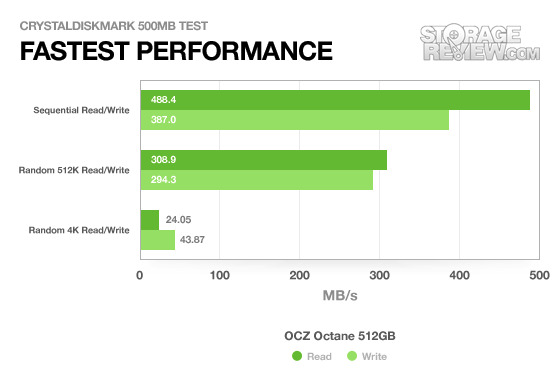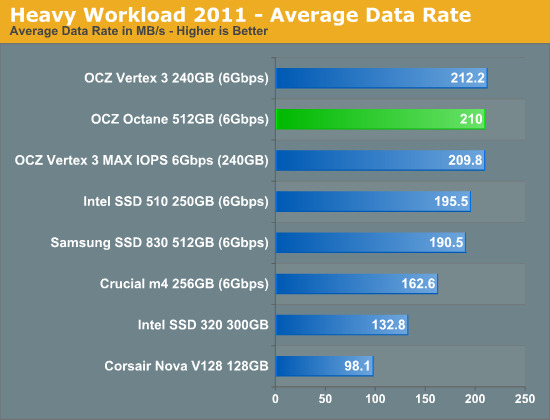OCZ Octane SSD Reviews Round-Up
This week we're seeing the fabulously powerful and relatively inexpensive OCZ Octane 1TB 2.5-inch SSD hit the review block, and what we're seeing here is that the manufacturers have backed up their claims in more ways than one. Price per gigabyte on this device is lower than the competition while the strength its displaying in this first round of hands-on looks is showing it to be more than a contender in the benchmark department. Could this be your next solid state drive, dare we ask?
While the OSZ Octane has been promised to achieve read / write speeds of 560MB/s for reading and 400MB/s for writing, it appears that reviewers have found this to be not all that far off from the truth. Have a peek at the specifications in this new OCZ offering first, then see what the real deal is.
OCZ Octane Specs
128GB (OCT1-25SAT3-128G) $199.99 ($1.56/GB)
256GB (OCT1-25SAT3-256G) $369.99 ($1.45/GB)
512GB (OCT1-25SAT3-512G) $879.99 ($1.72/GB)
1TB (OCT1-25SAT3-1TG)
• 512GB Formatted Capacity: 476.94GB
• Indilinx Everest platform
• Up to 560MB/s Read (1TB Capacity)
• Up to 400MB/s Write (512GB and 1TB Capacity)
• 512MB Onboard Cache
• 25nm Intel Synchronous NAND
• TRIM Support
• SATA 6Gb/s interface
• NCQ Support up to 32 Queue Depth
• 9.5mm, 2.5" form factor
• Dynamic & Static Wear-Leveling, and Background Garbage Collection
• 8 channels with up to 16-way Interleaving
• Power Consumption: 1.98W active, 1.15W standby
Let's have a look at a few different perspectives here, each from different sides of the internets, starting with PC Perspective's Allyn Malventano who comments on both the contents of the package and the size along with a couple results in a chart below:
"The Octane comes packaged like many other SSD's out there, with a few extra presents like the "My SSD is faster than your HDD" sticker seen with Vertex units. ... 1TB – in a 2.5" form factor SSD! HDD's hit this mark not too long ago, and while a 1TB Octane will most certainly cost a pretty penny, there's something to be said for SSD's so rapidly catching up to HDD's for a given form factor. ... Octane did well in sequential transfers with HDTach, but remember this particular test hits drives with a string of sequential (QD=1) IO, a notorious weakness of SandForce controllers." – Malventano

Next see what Kevin OBrien of Storage Review had to say on another synthetic benchmark test by the name of Iometer, with the single chart showing off a Workstation 4K model profile, with results below:
"Our last section of synthetic benchmarks looks at the performance of each drive in enterprise profiles, including database, webserver, file server, and workstation. One of the main benefits of this test over other synthetic benchmarks is the mixed workload with both read and write transfers as well as varied transfer sizes at the same time. These are also scaled from a queue depth of 1 to 128 to fully stress the drive in a demanding environment. As you can see below the OCZ Octane stayed close to the group in the lower queue depths, but couldn't scale up as high under a multi-threaded workload; although it did manage to stay above the Crucial m4 in all but the webserver test." – OBrien

Then of course no review series based mainly in benchmarks would be complete without a visit by Anandtech's Anand Lal Shimpi himself. Check out Anand's review for a rather in-depth and interesting story on the history of OCZ if you like, otherwise just read this snippet on how well the drive works with their heavy workload test:
"When put to the test the Octane does not disappoint. It's within a couple MB/s of the SF-2281 based Vertex 3, and effectively one of the fastest 6Gbps drives on the market today. I included the old Indilinx Barefoot based Corsair Nova V128 to show just how far Indilinx has come here." – Anand

Look like a winner to you?
